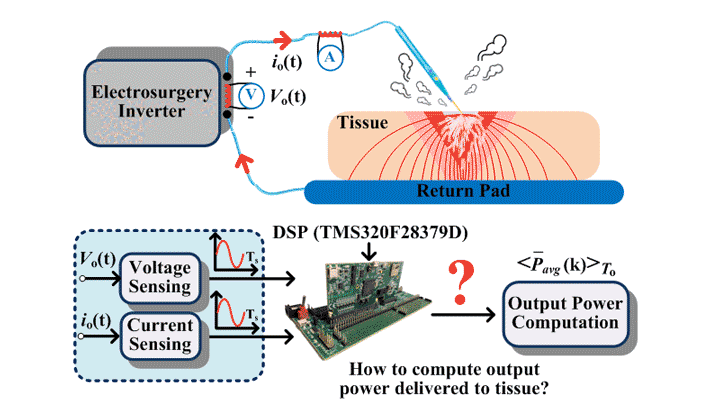Electrosurgery applies alternating signals with a fundamental frequency of hundreds of kilohertz across biotissue to elicit clinical effects. It is a practical challenge to represent those high-frequency signals without an ultrafast-sampling rate. Highly nonlinear arcing, routinely occurring in electrosurgery, further deteriorates the situation and makes it more challenging to accurately compute output power using limited signal samplings.
Viewing that, this paper details two power-computing methods for an electrosurgical inverter involving high-frequency and nonlinearly distorted outputs. The sparse-sampling-based approach samples output voltage once and current twice per cycle to calculate output power. The arcing occurrence distorts outputs and negatively impacts the power computational accuracy of this method. Thereby, the multi-sampling-based approach increases the sampling rate to 28 per cycle. The performance of the two methods is examined on a gallium nitride (GaN)-based high-frequency inverter prototype that allows electrosurgery with a fundamental output frequency of 390 kHz. It turns out that the sparse-sampling-based method features high power precision for most of the cases. With increased sampling speed and computation burden, the multi-sampling-based approach can enhance power calculation fidelity. Given the characteristics of the two methods, it depends on the actual case to decide which way is better by balancing sampling speed, digital computation power, and accuracy.
This paper also investigates the relationship of load impedance against the electrode insertion depth and cutting speed. Evolving from this relationship, an impedance-based power adaptation strategy is proposed to reduce collateral tissue damage. The experimental trials conducted on fresh pork validate that this strategy can autonomously modify output-power settings in an ultrafast manner. The resultant cutting traces present smaller thermal spreads, namely, reduced tissue damage when compared to those performed by conventional fixed power settings. Therefore, the impedance-based power adaptation reduces both tissue damage and sensor count, which may motivate further interdisciplinary research towards zero-collateral-damage electrosurgery.

